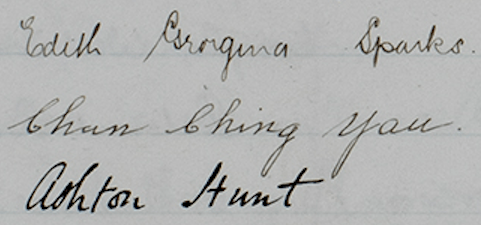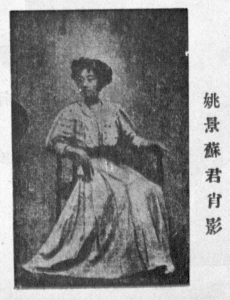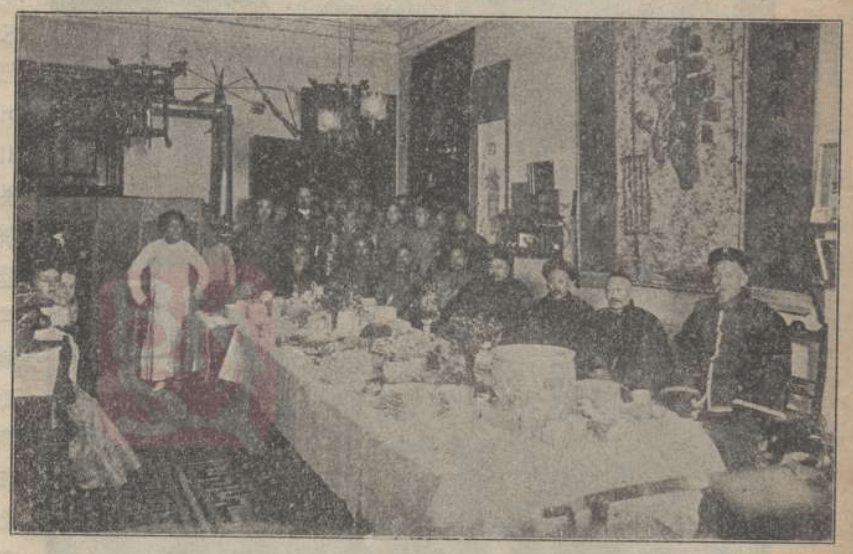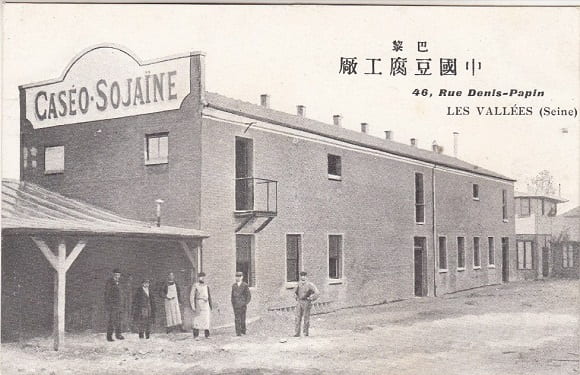Chan Ching Yau: The first Chinese undergraduate at the University of Bristol
‘In passing’, a colleague in our Library Special Collections recently wrote in an email to me, ‘I saw the attached entry in the ‘Register of Undergraduates’. ‘Passing’ being relative, he appended the file reference number and all the details: Chan Ching Yau, of 3170 Great Western Road, Shanghai (date of birth: 21 August 1897; matriculated: 27 November 1916).[1] Mr Yau’s entry was no 1,027. ‘I wonder what happened to him?’, he signed off, provocatively.
 So began a lockdown project. In academic year 2019-20 over 2,300 students from China, Hong Kong, and Taiwan, were studying at the University of Bristol, but Yau’s is the first Chinese name ever to have appeared in the register. The annual University Calendar, which cumulatively recorded the names of all graduates up to the 1939-40 edition, showed that he graduated with a BSc in Civil Engineering in July 1919, and what immediately happened next to Chan Ching Yau is easy to find out: on 22 October 1919 he boarded the White Star line’s SS Lapland at Southampton and sailed to New York.
So began a lockdown project. In academic year 2019-20 over 2,300 students from China, Hong Kong, and Taiwan, were studying at the University of Bristol, but Yau’s is the first Chinese name ever to have appeared in the register. The annual University Calendar, which cumulatively recorded the names of all graduates up to the 1939-40 edition, showed that he graduated with a BSc in Civil Engineering in July 1919, and what immediately happened next to Chan Ching Yau is easy to find out: on 22 October 1919 he boarded the White Star line’s SS Lapland at Southampton and sailed to New York.
The immigration record notes that Yau was born in Beijing, and was 5ft 5in tall, but what struck me immediately about the passenger list is that Yau was accompanied by his wife, Ivy. Gloucester-born Ivy Hillier, daughter (according to her baptismal record) of a cowman who later became a farm bailiff, had married Yau in Somerset in 1917. It seems likely that she was in domestic service when they met, for in the 1911 census she was listed as a nursemaid at a school in Weston-Super-Mare.
Ivy proved to be key to unlocking Chan Ching Yau’s story, as far as I can recover it, for she is mentioned under her maiden name in a family history, The Zhangs of Nanxun, published in 2010 and co-authored by Laurence and Nelson Chang. While the couple were at sea, Yau’s older sister, Yau Hui 姚蕙, was fatally injured in a freak accident in a New York park when a tree branch fell and hit her. Ivy Hillier found herself on arrival in New York helping to look after Yau Hui’s five traumatised, ‘spoiled and headstrong’ daughters, who lived with their uncle, Foo Yau Chang and his wife in an apartment on W108th St. It is hardly surprising to find the family history noting that for an Englishwoman from rural Gloucestershire, this unexpected turn in the course of her life proved equally unsettling. But, as a result, the Changs record her in the text by her maiden name.[2]
In 1923 this ménage travelled to China, the couple accompanying Yau’s older brother, the girls, and their mother’s remains which were then taken to the Zhang family mausoleum in Nanxun, a town equidistant between Hangzhou and Suzhou in eastern China’s Zhejiang province. I do not know what Yau did in New York. He may have worked with his brother (although in the 1920 census he lists his occupation as ‘Engineer, Civil’), but he may well also have pursued further study. I have found a few brief references to Yau’s subsequent career. In 1926-28, he was employed by the Rockefeller Foundation-funded Peking Union Medical College as Chief Engineer, known there as Yu-Van Yau (or Yuvan, possibly a transliteration of the Chinese for John: Yuehan (in Mandarin)).[3] The was a grandly conceived ‘Johns Hopkins for China’, a medical school that would have a profound impact on the evolving new medical infrastructures being created across China. It is also probable that he is the man referred to in a 1927 note that ‘A highly qualified Chinese engineer has lately been placed in charge of the mechanical equipment, filling a position formerly held by foreigners’.[4] In the 1930s, Yau is said to have taught at a municipal school in the International Settlement. At the same time, between about 1932 and 1937, he privately tutored two sons of Zhang Shuxun, a cousin of his former brother in law, Yao Hui’s husband Zhang Jingjiang 張靜江, who is better known as Zhang Renjie 張人杰. Yau, wrote Chang, slightly mis-remembering,
was very Westernized, as he had been educated at Cambridge University and was married to a British woman. As a result, we learned much from him about Western customs, manners, and culture.[5]

Yao Hui (Yao Jingsu), from an article in Shennü Shibao 婦女時報 May 25, 1913
Some of these names are familiar to students of modern Chinese history and culture. Yao Hui was a prominent feminist and literary figure. A poet herself, she was, as Yao Jingsu 姚景蘇, a member of the editorial board of the magazine Shenzhou Nübao 神州女報, in which she published literary articles. Her brother, C. F. Yau – Chang Foo Yau 姚昌復 – was a prominent gallery owner in New York, managing his brother-in-law’s business, the Ton-Ying Gallery, which relocated from Paris during the First World War. Ton-ying (Tongyun 通运公司) had been founded by Zhang in 1902, when he was posted to Paris as a junior diplomatic official.[6] The New York branch had opened on 1 March 1915 on 5th Avenue. As well as operating a bank, and a teahouse in Paris, in 1909 Jiang with his friend Li Shizeng, had also founded Europe’s first beancurd factory.

The Yau siblings grew up in a literary family, their father, best known as Yao Jupo (姚菊坡, also: 姚菊岐, 姚丙然)), was a scholar, and chief education official in Shandong Province before he was sacked for corruption. Yao was heavily involved in the International Institute of China 尚賢堂. Although its origins lay in the missionary world, and it was originally known as the Mission among the Higher Classes in China, this was in fact an enterprise aiming to promote what we would now call intercultural dialogue. It had been established in 1897 by American missionary Gilbert Reid, a controversial figure who was the subject of a scathing critique by Mark Twain, ‘The Ethics of Loot’, about his role in the aftermath of the Boxer Uprising. Very closely associated with reformist officials involved in 1898 in what was called the ‘One Hundred Days’ of radical reform that was cut short by a conservative coup, the Institute and its activities relocated from Beijing to Shanghai in 1903, where it offered classes and public lectures. Yao died in early February 1916, and Reid composed an obituary and presented a tribute to his friend of twenty years standing at a memorial service in Shanghai.[7] Here is Yau senior (one of the three men seated on the right) at a dinner to celebrate Reid’s fiftieth birthday in 1907.

Chan Ching Yau’s brother-in-law, Zhang Jingjiang, had long been involved in political activity, and was a strong supporter before the 1911 revolution in China of the revolutionary leader Sun Yat-sen (who stayed in their apartment when visiting Paris). Zhang remained so, returning to China from France immediately after the revolution broke out. In Shanghai he became heavily embroiled in financial and political affairs, would become one of the right-wing elder statesmen in the political party Sun founded and led until his death in early 1925, the Guomindang, and a friend and sponsor of Sun’s successor as party leader, Chiang Kai-shek. After Yao Hui’s daughters, the eldest of whom was 17 at her death, returned to China they were befriended by Chiang’s first wife, while one of them married Eugene Chen (Chen Youren), the Trinidad-born politician who became Foreign Minister in the Guomindang’s revolutionary National Government.
This is a notable pedigree, encompassing art and culture, the missionary enterprise, Qing reformers, and different strands of twentieth century radical and conservative nationalist politics, and feminism. We might also remember the beancurd.
It has been hard to trace Chan Ching Yau otherwise. His father’s obituary records that he was already in Britain in February 1916, and it would make sense to assume that he had earlier joined his older brother in Paris, probably before the outbreak of war in August 1914. He and Ivy had a son, Arthur Joseph Yau, who was born in New York in February 1921, and who in February 1949 moved to the United States from China. Arthur Yau settled in Burlington, Massachusetts. In May 1927 Ivy had taken him to Britain, sailing at the high-tide of the Guomindang’s Northern Expedition, during which it launched its National Revolutionary Army, led by Chiang, which saw it established a new National Government with Nanjing as its capital. Ivy gave her address as 18 Ma Chao Miao in Peking (and her husband’s name as Yuvan, as his brother had also recorded it in 1926).[8] Her passage across the Pacific, and that of another British woman married to a Chinese man on the same vessel, was paid for by the Peking Union Medical College. Mother and son sailed to Seattle, and then out of New York 18 days later, making their way back to China in April the following year travelling via Suez to complete a circumnavigation of the globe.
Almost thirty years later, Ivy returned to Britain. In July 1958 she landed at Liverpool, having been living in the United States, travelling on to live in north Bristol with her sister and brother in law. Ivy Yau died in Horfield, Bristol, in September 1969 on the day of her 80th birthday. Her grandson recalled that she had lived with them in Massachusetts for a few months before she moved on, having left her husband, but it is not clear when she entered the US. She claimed, he later noted in a poem, ‘to be a descendant of the Huguenots’, which he in his child’s mind conflated with the Argonauts. Perhaps he was closer to the spirit of her life’s voyage than he thought.[9]
Chan Ching Yau himself seems to have China in late 1956, when as Yuvan Yau he is recorded as one of the passengers arriving at Hong Kong on a ship that had sailed from Tianjin and Shanghai.[10] He will not have had an easy time in China after the Communist Party seized power in 1949 and established the People’s Republic. His own Chen family background, the family’s network of relations with the defeated Guomindang, his professional status – which made him an intellectual in the rigid caste system of the new regime – his Anglophone education and cosmopolitan background, and probably even his foreign wife, would have made him an obvious target. He did well to leave when he did.
So, that stray reference, a name noticed ‘in passing’, set off a search that led me swiftly into a rich historical landscape, woven across with forking paths that could track us this way into revolutionary politics, that way the international trade in Chinese art and antiquities, there feminist literary culture and political activism, or high finance in Shanghai (and low, for Zhang Jingjiang was embedded in Green Gang networks), the Protestant missionary enterprise at the end of the Qing, social gospel initiatives such as PUMC that evolved from it and presaged the era of international humanitarianism, and China’s cosmopolitan modern cultures, international mobilities and international migration. That reference, glimpsed in passing, that recorded the moment a young Chinese man presented himself in suburban Bristol to commence his studies, offers a direct route from the heart of this university into the heart of China’s long and arduous twentieth century.
In preparing this post I have greatly benefited from the assistance of Vivian Kong, and Ning Jennifer Chang, who found vital references, and I am grateful, too, to Jamie Carstairs, who set me off, and to John Yau.
[1] ‘Register of Undergraduates 1’, DM2287/9/4.
[2] Laurence Chang & Nelson Chang, with Song Luxia, The Zhangs of Nanxun: A One Hundred and Fifty Year Chronicle of a Chinese Family (Boulder: C.F. Press, 2010), pp. 270-71.
[3] A personnel record is listed in the China Medical Board Archives finding aid at the Rockefeller Archives, datd 1926-28: https://dimes.rockarch.org/xtf/media/pdf/ead/FA065/FA065.pdf , p. 150.
[4] The Rockefeller Foundation, Annual Report 1926 (New York: Rockefeller Foundation, 1927), p. 301. In its 1928 report, Yu-Van Yau is listed as Chief Engineer: Peking Union Medical College, Annual Announcement (Peking, 1928), p. 20.
[5]Chang & Chang, with Song , The Zhangs of Nanxun, p. 425. Elsewhere in the book Yau is described as an Oxford graduate.
[6] https://carp.arts.gla.ac.uk/essay1.php?enum=1096638570; New York Times, 15 March 1915, p. 4.
[7] Tsou Mingteh, ‘Gilbert Reid (1857-1927) and the Reform Movement in the Late Qing’, in Daniel H. Bays (ed.), Christianity in China From the Eighteenth Century to the Present (Stanford: Stanford University Press, 1996), pp. 73-90; Renata Vinci, ‘Meeting the West in a Conference Hall: Gilbert Reid’s Lectures at the International Institute in Shanghai’, in Marina Miranda (ed.), Dal Medio all’Estremo Oriente. Studi del Dottorato di Ricerca in ‘Civiltà dell’Asia e dell’Africa’ (Rome: Carocci, 2018), pp.119-13; ‘姚先生’, 尚賢堂紀事第7卷第3期(1916), pp. 5-6; ‘纪本堂为姚菊坡先生开追悼会事’, in 尚賢堂紀事第7卷第6期 (1916), pp. 20-25.
[8] A problem with searching for the Yau family, and others, is that people used various names. (In addition, Yau is now written as Yao in the Hanyu Pinyin transliteration system, but in this period might be Yau or Yao). They might have a Zi (字) a courtesy name, and a Hao. In this case also, foreign immigration officials mangled the Chinese names they heard, misread what they received (Yau becoming Yan), and in addition Francophone and Anglophone conventions differed. Yao Hui was Mrs Ysang on arrival from Europe in 1917, also Tsang, Chang, and sometimes can be found today referred to as Zhang Yaohui, but also Zhang Jingsu, Jingsu being her pen-name.
[9] John Yau, ‘Ing Grish’ (2005) in Joshua Beckman & Matthew Zapruder (eds), State of the Union: Fifty Political Poems (New York: Wave Books, 2008), p. 74.
[10] ‘Coming and Going: Arrivals from China’, South China Morning Post, 31 October 1956, p. 5.

